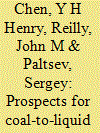|
|
|
Sort Order |
|
|
|
Items / Page
|
|
|
|
|
|
|
| Srl | Item |
| 1 |
ID:
116738


|
|
|
|
|
| Publication |
2012.
|
| Summary/Abstract |
We investigate the impact of climate policies on Canada's oil sands industry, the largest of its kind in the world. Deriving petroleum products such as gasoline and diesel from oils sands involves significant amounts of energy, and that contributes to a high level of CO2 emissions. We apply the MIT Emissions Prediction and Policy Analysis (EPPA) model, a computable general equilibrium model of the world economy, augmented to include detail on the oil sands production processes, including the possibility of carbon capture and storage (CCS). We find: (1) without climate policy, annual Canadian bitumen production increases almost 4-fold from 2010 to 2050; (2) with climate policies implemented in developed countries, Canadian bitumen production drops by 32% to 68% from the reference 4-fold increase, depending on the viability of large-scale CCS implementation, and bitumen upgrading capacity moves to the developing countries; (3) with climate policies implemented worldwide, the Canadian bitumen production is significantly reduced even with CCS technology, which lowers CO2 emissions at an added cost. This is mainly because upgrading bitumen abroad is no longer economic with the global climate policies.
|
|
|
|
|
|
|
|
|
|
|
|
|
|
|
|
| 2 |
ID:
109404


|
|
|
|
|
| Publication |
2011.
|
| Summary/Abstract |
Two computable general equilibrium models, one global and the other providing U.S. regional detail, are applied to analysis of the future of U.S. natural gas. The focus is on uncertainties including the scale and cost of gas resources, the costs of competing technologies, the pattern of greenhouse gas mitigation, and the evolution of global natural gas markets. Results show that the outlook for gas over the next several decades is very favorable. In electric generation, given the unproven and relatively high cost of other low-carbon generation alternatives, gas is likely the preferred alternative to coal. A broad GHG pricing policy would increase gas use in generation but reduce use in other sectors, on balance increasing its role from present levels. The shale gas resource is a major contributor to this optimistic view of the future of gas. Gas can be an effective bridge to a lower emissions future, but investment in the development of still lower CO2 technologies remains an important priority. International gas resources may well prove to be less costly than those in the U.S., except for the lowest-cost domestic shale resources, and the emergence of an integrated global gas market could result in significant U.S. gas imports.
|
|
|
|
|
|
|
|
|
|
|
|
|
|
|
|
| 3 |
ID:
094856


|
|
|
|
|
| Publication |
2010.
|
| Summary/Abstract |
This paper estimates the value of international emissions trading, focusing on a here-to-fore neglected component; its value as a hedge against uncertainty. Much analysis has been done of the Kyoto Protocol and other potential international greenhouse gas mitigation policies comparing the costs of achieving emission targets with and without trading. These studies often show large cost reductions for all Parties under trading compared to a no trading case. We investigate the welfare gains of including emissions trading in the presence of uncertainty in economic growth rates, using both a partial equilibrium model based on marginal abatement cost curves and a computable general equilibrium model. We find that the hedge value of international trading is small relative to its value in reallocating emissions reductions when the burden sharing scheme does not resemble a least cost allocation. We also find that the effects of pre-existing tax distortions and terms of trade dominate the hedge value of trading. We conclude that the primary value of emissions trading in international agreements is as a burden sharing or wealth transfer mechanism and should be judged accordingly.
|
|
|
|
|
|
|
|
|
|
|
|
|
|
|
|
| 4 |
ID:
098589


|
|
|
|
|
| Publication |
2010.
|
| Summary/Abstract |
To evaluate the socio-economic impacts of air pollution, we develop an integrated approach based on computable general equilibrium (CGE). Applying our approach to 18 western European countries shows that even there, where air quality is relatively high compared with other parts of the world, health-related damages caused by air pollution may be substantial. We estimate that as of 2005, Europe experienced an annual loss in consumption of about 220 billion Euro in year 2000 prices (about 3% of total consumption) with a range based on 95% high and low epidemiological response functions of 107-335 billion Euro and a total welfare loss of about 370 billion Euro (range of 209-550) including both consumption and broader welfare losses (around 2% of welfare level) due to the accumulated effects of three decades of air pollution in Europe. In addition, we estimate that a set of air quality improvement policy scenarios as proposed in the 2005 CAFE program would bring 18 European countries as a whole a welfare gain of 37-49 billion Euro (year 2000 prices) in year 2020 alone.
|
|
|
|
|
|
|
|
|
|
|
|
|
|
|
|
| 5 |
ID:
109315


|
|
|
|
|
| Publication |
2011.
|
| Summary/Abstract |
We investigate the economics of coal-to-liquid (CTL) conversion, a polygeneration technology that produces liquid fuels, chemicals, and electricity by coal gasification and Fischer-Tropsch process. CTL is more expensive than extant technologies when producing the same bundle of output. In addition, the significant carbon footprint of CTL may raise environmental concerns. However, as petroleum prices rise, this technology becomes more attractive especially in coal-abundant countries such as the U.S. and China. Furthermore, including a carbon capture and storage (CCS) option could greatly reduce its CO2 emissions at an added cost. To assess the prospects for CTL, we incorporate the engineering data for CTL from the U.S. Department of Energy (DOE) into the MIT Emissions Prediction and Policy Analysis (EPPA) model, a computable general equilibrium model of the global economy. Based on DOE's plant design that focuses mainly on liquid fuels production, we find that without climate policy, CTL has the potential to account for up to a third of the global liquid fuels supply by 2050 and at that level would supply about 4.6% of global electricity demand. A tight global climate policy, on the other hand, severely limits the potential role of the CTL even with the CCS option, especially if low-carbon biofuels are available. Under such a policy, world demand for petroleum products is greatly reduced, depletion of conventional petroleum is slowed, and so the price increase in crude oil is less, making CTL much less competitive.
|
|
|
|
|
|
|
|
|
|
|
|
|
|
|
|
|
|
|
|
|